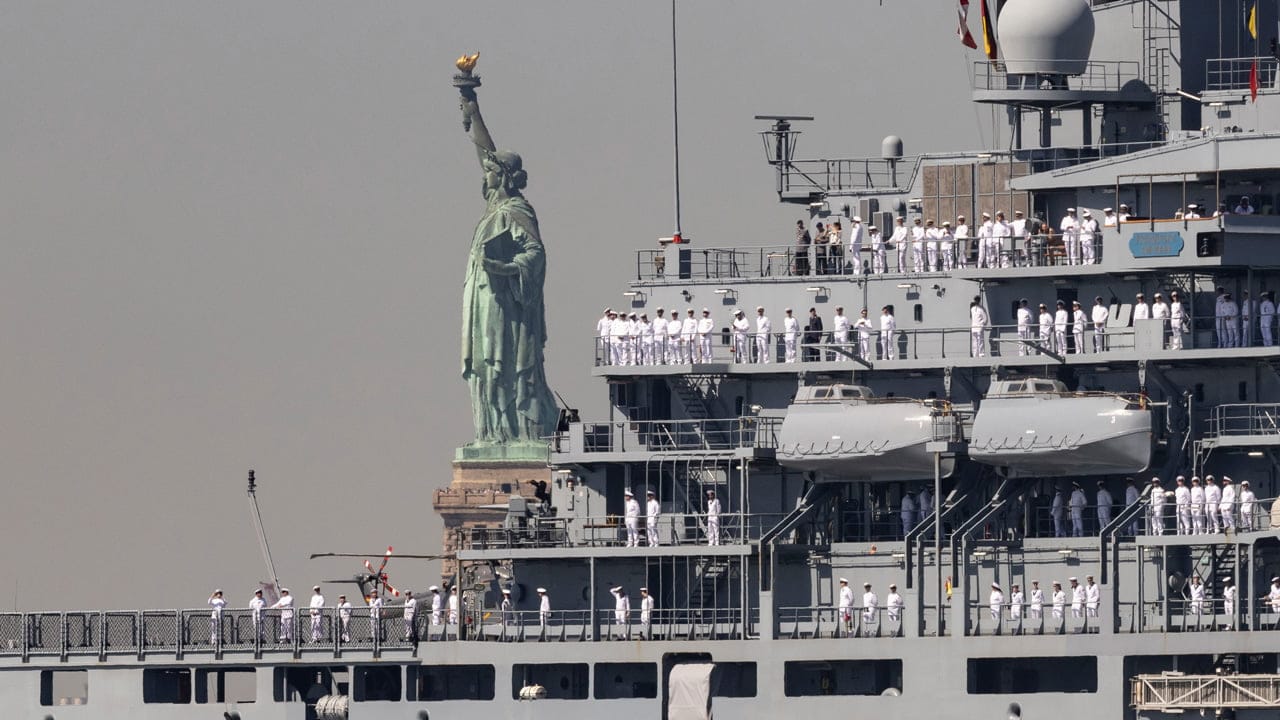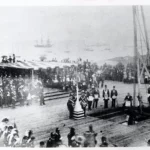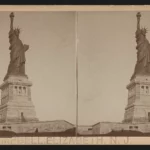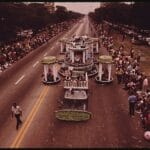Americans, get ready to step back in time as we uncover the tales of two legendary events: Yorktown Parade Day and the Liberty Statue Ceremony. Think of it like a treasure hunt for the soul of our nation. From Yorktown’s gunpowder-filled battlefields to Lady Liberty’s triumphant arrival, we’ll dig into the stories behind these iconic celebrations. Brace yourself for a time-traveling adventure that’ll show you why these traditions still rock our socks off today.
Yorktown Parade Day and Liberty Statue Ceremony
Get ready for a day of remembrance and celebration in historic Yorktown! This October 19th, the town will come alive with the sights and sounds of the annual Yorktown Day Parade and Liberty Statue Ceremony, coinciding with the 2024 Reunion of the USS Yorktown CG-48 Association.
This poignant occasion presents a unique opportunity to honor the veterans who served aboard the USS Yorktown CG-48 and acknowledge the sacrifices made throughout history. In a gesture of respect for these brave individuals, attendees are encouraged to wear business casual attire.
The Yorktown Day Parade itself is a sight to behold, a vibrant spectacle that honors the American victory in the Revolutionary War. Imagine: colorful floats, marching bands, and inspiring speeches that highlight the courage and resilience of those who fought for independence. The parade culminates in a moving ceremony at the Jack DeVito Veterans Memorial Field & Track, a fitting tribute to those who served our country.
But there’s more to experience in Yorktown than just the parade. The town itself is steeped in history. The Jamestown-Yorktown Foundation offers a fascinating glimpse into the past, allowing visitors to learn all about the pivotal Battle of 1781, which many historians believe was a turning point in the American Revolution. Discover how this pivotal battle unfolded and explore its lasting impact on the course of American history.
And that’s not all! Immerse yourself in the events of the Yorktown Victory Celebration. Picture this: a solemn wreath-laying ceremony that pays homage to the fallen, followed by the exciting sights and sounds of the parade. As you wander through the historic streets, you’ll likely hear the lively tunes of the Fifes and Drums of Yorktown, transporting you back to the 18th century.
To truly grasp the magnitude of this historical event, take some time to explore the Colonial National Historical Park and the American Revolution Museum at Yorktown. These sites offer a tangible connection to the past, allowing you to walk in the footsteps of those who shaped the nation. You can almost feel the weight of history as you stand on the grounds where the British surrendered in 1781, effectively securing America’s hard-won independence.
Don’t miss out on this opportunity to immerse yourself in history and honor those who bravely fought for our freedom. Join the festivities in Yorktown this October 19th and experience the excitement of the Yorktown Day Parade and the solemnity of the Liberty Statue Ceremony.
If you’re curious about the Yorktown victory celebrations and the grand Statue of Liberty dedication events, check out the links for more information and see how these events played a significant role in shaping our nation’s history.
What Day is Yorktown Day?
Yorktown Day celebrates the momentous victory at the Siege of Yorktown on October 19th, 1781. This decisive victory marked a pivotal turning point in the American Revolution, paving the path to independence.
Yorktown Day is observed annually on the third Saturday in October. Mark your calendars, folks, because in 2023, that means Yorktown Day falls on October 21st.
The heart and soul of Yorktown Day is undoubtedly the parade. Picture this: floats decked out in red, white, and blue, the energy of marching bands, proud military units, and people from all sorts of local organizations coming together. It’s a real community affair! This year, they’re expecting over 35 groups to participate in the parade, promising a spectacular event!
Want to catch the action? The parade kicks off at 10:30 in the morning, starting at the corner of Ballard and Main Streets. From there, it winds its way down Main Street before finally wrapping things up at the intersection of Main and Alexander Hamilton Boulevard.
Yorktown Day isn’t just about the past, though. It’s a chance to reflect on what those brave individuals fought for and to celebrate the freedoms we often take for granted. It’s a day to be proud of our history and the community we’re part of.
How many people died in the Battle of Yorktown?
The Battle of Yorktown, the pivotal clash that essentially sealed the deal for American independence, was a full-blown siege that dragged on for weeks, from September 28th to October 19th, 1781. While we celebrate the victory, it’s important to remember that victories like this one came at a real cost, a human cost. However, determining the precise number of casualties isn’t as straightforward as one might think.
Record-keeping during the heat of battle in the 18th century was far from a top priority. While some figures exist, the true casualty count is likely higher than what’s officially documented. Historians estimate that around 857 soldiers died during the Battle of Yorktown. That includes soldiers from both sides – the Continental Army and their French allies, as well as the British forces.
The figure of 857 represents the soldiers killed in action. It’s crucial to remember that many more were wounded, some so severely they may have died later from their injuries or infections. Additionally, conditions for prisoners of war were harsh, and many likely succumbed to disease or starvation.
The Battle of Yorktown was a turning point in the American Revolution, and while we celebrate the victory, it’s crucial to acknowledge the sacrifices made on that battlefield.
Which important event happened in Yorktown, Virginia?
In 1781, amidst the heat of the American Revolution, Yorktown, Virginia, a seemingly quiet town, became the stage for a showdown that would change the course of history.
British General Cornwallis and his troops established a strategic encampment in Yorktown. However, their choice of location proved to be a grave miscalculation.
The American and French forces, led by General George Washington, recognized an opportunity and seized it. They swiftly surrounded Yorktown, effectively trapping Cornwallis and his army. The ensuing engagement became known as the “Siege of Yorktown.”
The siege raged for weeks, a grueling test of endurance and military prowess. Cannons roared, muskets fired, and both sides fought valiantly. Ultimately, the combined American and French forces proved insurmountable. Cornwallis, acknowledging his dire predicament, made the difficult decision to surrender.
The victory in Yorktown marked a pivotal turning point in the American Revolution. The British defeat dealt a significant blow to their morale and their grip on the colonies. Moreover, it signaled to the world that the Americans were resolute in their fight for independence.
Today, Yorktown stands as a proud testament to this pivotal moment. The Yorktown Victory Monument, a soaring tribute to the Franco-American alliance that secured victory, graces the landscape. The American Revolution Museum at Yorktown provides an immersive journey into the details of the war and the siege itself. Every year, Yorktown hosts a grand Victory Celebration, a time to reflect on the past and celebrate the indomitable spirit of freedom.
How many days did the American forces bombard the British at Yorktown?
The confrontation at Yorktown was not a swift encounter but rather a tense, drawn-out siege. For 21 days, from September 28th to October 19th, 1781, the American and French forces relentlessly pressured the British troops trapped within Yorktown.
The Americans and French, recognizing their numerical advantage, strategically opted against an immediate, full-frontal assault. Instead, they chose to weaken the British defenses with a relentless barrage of cannon fire. This constant bombardment persisted for 20 days, gradually wearing down the British troops and their defenses.
Finally, on October 19, 1781, British General Cornwallis, facing an untenable situation, made the decision to surrender. However, this was no ordinary surrender; it was a pivotal turning point in the American Revolution, a moment that signaled a potential shift in the balance of power.
The victory at Yorktown had a seismic impact. It decisively swung the momentum of the war in favor of the Americans and ultimately paved the way for peace talks and the Treaty of Paris, which officially recognized America’s independence.
What happened at Yorktown in September and October of 1781?
In the waning days of summer, 1781, the American Revolution had reached a critical juncture. The British army, under the command of General Cornwallis, was encamped at Yorktown, Virginia, seemingly confident in their position. However, they were unaware of the strategic masterstroke about to unfold.
General George Washington, the astute leader of the Continental Army, sensing an opportunity to deliver a decisive blow, devised a daring plan in collaboration with the French forces led by the Comte de Rochambeau. Their objective: to encircle Yorktown, effectively trapping the British.
The combined American and French forces embarked on their march toward Yorktown, their sheer size and determination sending shockwaves through the British ranks.
By late September, the siege of Yorktown commenced in earnest. Day and night, cannons roared, bombarding the British defenses. The deafening noise, the smoke-filled air, and the constant threat of bombardment took a heavy toll on the British.
Cornwallis’s woes were compounded by the French fleet, commanded by Admiral de Grasse, which had sailed into Chesapeake Bay, effectively cutting off any hope of escape or reinforcement.
Trapped on land and blockaded by sea, Cornwallis and his army faced a dire predicament. Food and ammunition dwindled, morale plummeted, and options rapidly evaporated.
After weeks of relentless bombardment and with all hope of relief extinguished, Cornwallis reluctantly raised the white flag on October 19th, 1781. The British army, defeated and demoralized, marched out of Yorktown, their aspirations of crushing the rebellion dashed.
News of the surrender at Yorktown reverberated across the Atlantic. In America, it ignited a wave of jubilation and ignited the belief that victory was within grasp. Although the war would officially continue for two more years, the outcome was no longer in doubt. The Americans, bolstered by their French allies, had demonstrated their unwavering resolve and capability to secure their independence.
The victory at Yorktown transcended the battlefield; it had a profound and enduring impact on history. It served as a testament to the power of a determined group of revolutionaries to topple even the mightiest of empires.
What is Modern Day Yorktown?
While renowned for its pivotal role in the American Revolution, Yorktown is far from frozen in time. This vibrant town seamlessly blends its rich historical legacy with a lively contemporary spirit.
One of the most captivating aspects of modern-day Yorktown is its unwavering commitment to celebrating its history. Each year, the town hosts the grand Yorktown Victory Celebration, a multi-day extravaganza commemorating the momentous triumph in the Revolutionary War. Imagine parades, historical reenactments, and special tours – a complete immersion into the past!
Speaking of immersing oneself in history, a visit to the American Revolution Museum at Yorktown is an absolute must. This isn’t your typical, stuffy history museum. Interactive exhibits, fascinating artifacts from the war, and engaging displays make learning about this period both fun and informative.
Here’s a quick snapshot of modern-day Yorktown:
| Feature | Description |
|---|---|
| Yorktown Parade Day | A special day to remember the significant victory on October 19, 1781, with (you guessed it!) a parade! |
| Yorktown Victory Celebration | A multi-day event with a diverse range of activities celebrating Yorktown’s role in the Revolution. Think of it as a history festival! |
| American Revolution Museum | A museum dedicated to, well, the American Revolution! It’s a fantastic place to delve deeper into the events that transpired in Yorktown and beyond. |
What’s truly remarkable about Yorktown is its ability to not only remember its past but also embrace it. Visiting is like taking a captivating step back in time, but in a fun, engaging, and thought-provoking way. It makes you realize how events from centuries ago continue to resonate and shape our world today.
Information based on sources like the Yorktown tourism website (https://www.visityorktown.org/event/yorktown-victory-celebration-4/).
What national day is July 11?
While July 11th might not have the same historical weight as some other dates, it does hold a special place on the calendar, especially for those with a sweet tooth. Grab your shades and get ready for some frosty fun because it’s National 7-Eleven Day! That’s right, the ubiquitous convenience store with the quirky name gets a whole day to itself. And since no 7-Eleven celebration would be complete without their signature frozen drink, it’s also affectionately known as National Slurpee Day.
Now, you might be wondering, “A whole day dedicated to a convenience store?” But 7-Eleven occupies a unique niche in our collective consciousness. It’s the go-to spot for late-night snacks, emergency gallons of milk, and of course, those brain-freezing Slurpees.
And what’s a celebratory day without a little something extra? 7-Eleven pulls out all the stops, offering enticing promotions and deals you won’t want to miss. But the cherry on top? Free Slurpees! Yep, you read that right. Just stroll into your local 7-Eleven on July 11th, and you could be sipping on a free Slurpee in no time.
This tradition of free Slurpees and 7-Eleven festivities isn’t exactly brand new. It all started back in 1967, and let’s just say it’s become a pretty big deal since then. National 7-Eleven Day has evolved into a highlight of the summer for 7-Eleven fans everywhere. It’s a fun, lighthearted way to celebrate a brand that’s become woven into the fabric of our everyday lives.
What day did the Americans win the Battle of Yorktown?
The hard-fought Battle of Yorktown reached its climax on October 19, 1781. This date marks the day the British, led by General Cornwallis, surrendered to the combined forces of the Americans and the French.
The siege itself had begun a few weeks earlier, on September 28th. The Americans and French held a crucial numerical advantage and employed clever siege tactics, bombarding the British relentlessly. This constant pressure gradually eroded the British defenses and ultimately led to their surrender.
Yorktown was a pivotal turning point in the Revolutionary War. The capture of over 8,000 British soldiers dealt a significant blow to the British war effort and provided a much-needed morale boost to the Americans.
The victory’s impact reverberated across the Atlantic, likely playing a significant role in persuading the British Parliament to commence peace negotiations. This ultimately led to the Treaty of Paris in 1783, officially recognizing the independence of the United States of America.
While October 19th marks the official surrender, some historians argue that specific earlier battles or strategic decisions during the siege sealed the British fate from the start. It’s a good reminder that history is complex, and even well-known events can be open to different interpretations.
If you find this battle as fascinating as we do, there’s a wealth of information available to explore! Websites like History.com offer deeper dives into the details of the siege, the key players involved, and its lasting impact on the course of American history. Happy reading!
What happened on Yorktown?
October 19, 1781, marked a pivotal moment in the American Revolution. General Cornwallis, the leader of the British forces, found himself backed into a corner, facing the combined might of the American and French armies, commanded by Generals George Washington and the Comte de Rochambeau.
Recognizing his precarious position, Cornwallis made the difficult decision to surrender. This pivotal moment, while not the absolute end of the war, represented a decisive turning point in favor of the Americans.
The British, already feeling the strain of years of fighting, suffered a major setback at Yorktown. It shattered their aura of invincibility and likely discouraged other European powers from allying with them. This significant shift in momentum paved the way for the Treaty of Paris in 1783, formally recognizing America’s independence.
It’s important to remember that this is a simplified account of a highly complex historical event. Historical research is ongoing, and there are always new insights to be uncovered about the Battle of Yorktown. For example, some historians are delving into the experiences of individual soldiers and civilians during the siege, while others are examining the intricate military strategies employed by both sides.
If you’re eager to delve deeper into this pivotal moment in American history, a visit to the American Revolution Museum at Yorktown is highly recommended. The museum’s collection of artifacts, exhibits, and immersive displays will transport you back to the heart of the action, potentially revealing fascinating details that challenge our current understanding of the Battle of Yorktown.
How many miles did the Continental Army march per day on their way to Yorktown?
The Continental Army’s arduous journey to Yorktown was no walk in the park. Imagine traversing over 600 miles on foot, a journey that spanned fourteen weeks and exposed them to the full fury of Mother Nature. Rain, heat, rough terrain, and the constant worry about supplies and navigating the wilderness were just a few of the challenges they faced.
Most accounts suggest they maintained a grueling pace of about 12 to 15 miles per day. While this might not seem like an extraordinary distance by today’s standards, these were soldiers carrying heavy gear, not athletes in modern athletic wear.
Their relentless pace played a crucial role in their eventual victory at Yorktown. It serves as a powerful reminder that wars aren’t solely won with muskets and cannons; sometimes, it’s the unwavering grit, determination, and resilience of the human spirit that ultimately tip the scales. Today, you can actually retrace portions of their historic journey along the Washington-Rochambeau Revolutionary Route, gaining a deeper appreciation for the immense effort they invested in securing our nation’s independence.
It’s worth noting that record-keeping in the 18th century wasn’t as precise as we’re accustomed to today. While estimates based on journals and reports provide valuable insights, there’s always the possibility of uncovering more precise details through ongoing research. Who knows what hidden stories are still out there, waiting to be discovered, about this incredible march?
- Mastering Leader in Spanish: The Complete Guide - April 19, 2025
- Uncovering Surprising Parallels: England Size Compared to US States - April 19, 2025
- Old Mexico Map: Border Shifts 1821-1857 - April 19, 2025

















1 thought on “Honoring History: A Celebration of Yorktown Parade Day and the Liberty Statue Ceremony”
Comments are closed.